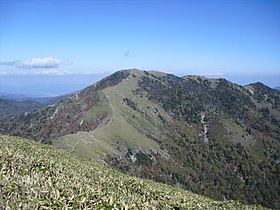Mount Tsurugi (Tokushima)
| Mount Tsurugi | |
|---|---|
| 剣山 | |
 |
|
| Highest point | |
| Elevation | 1,954.7 m (6,413 ft) |
| Prominence | 1,540 m (5,050 ft) |
| Listing | Ultra |
| Coordinates | 33°51′13″N 134°05′39″E / 33.85361°N 134.09417°ECoordinates: 33°51′13″N 134°05′39″E / 33.85361°N 134.09417°E |
| Geography | |
| Location | On the border of Miyoshi, Mima and Naka, Tokushima, Japan |
| Parent range | Shikoku Mountains |
| Geology | |
| Mountain type | Upheaval Peneplain |
Mount Tsurugi (剣山 Tsurugi-san?), meaning sword, is a 1,954.7-metre-high (6,413.1 ft) mountain on the border of Miyoshi, Mima and Naka in Tokushima Prefecture, Japan. This mountain is one of the 100 Famous Japanese Mountains.
Mount Tsurugi is the second highest mountain on the island of Shikoku, and also the second highest mountain west of Mount Haku, which is on the border of Ishikawa and Gifu prefectures in central Japan.
Mount Tsurugi is an important object of worship in this region and one of the centers of Shugendō, a sect of mixture of Shintoism and Buddhism. On the top of the mountain, there is a small shrine called ‘Tsurugi Jinja’.
The area around Mount Tsurugi is a major part of Tsurugi Quasi-National Park.
Mount Tsurugi has an altitude-affected humid continental climate (Köppen climate classification Dfb) with mild summers and cold winters.
Tsurugi Jinja (Tsurgi Shrine) on the top of Mount Tsurugi
Mount Jirogyu from the top of Mount Tsurugi
A view of the middle of Mount Tsurugi
Another view of the middle of Mount Tsurugi
...
Wikipedia

